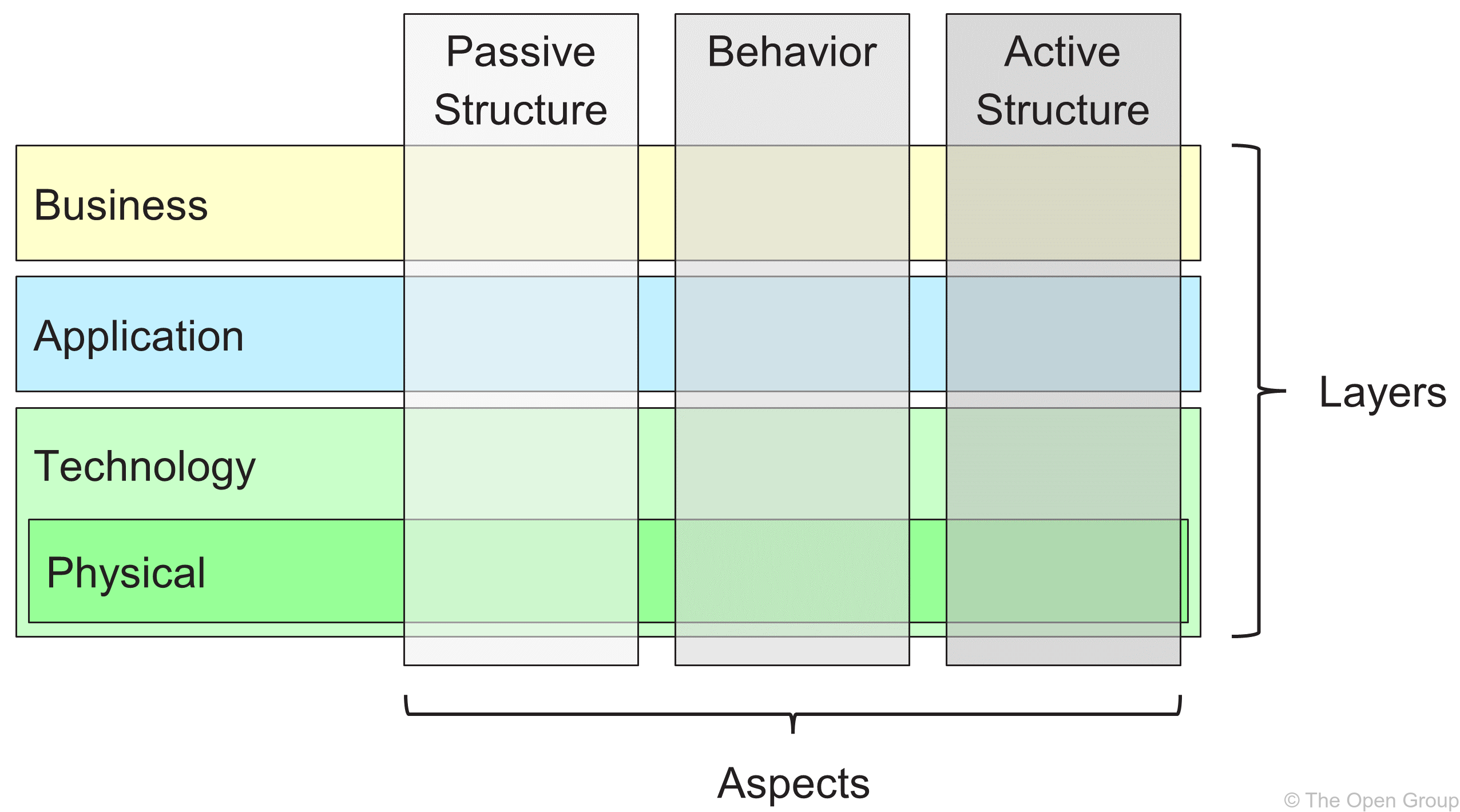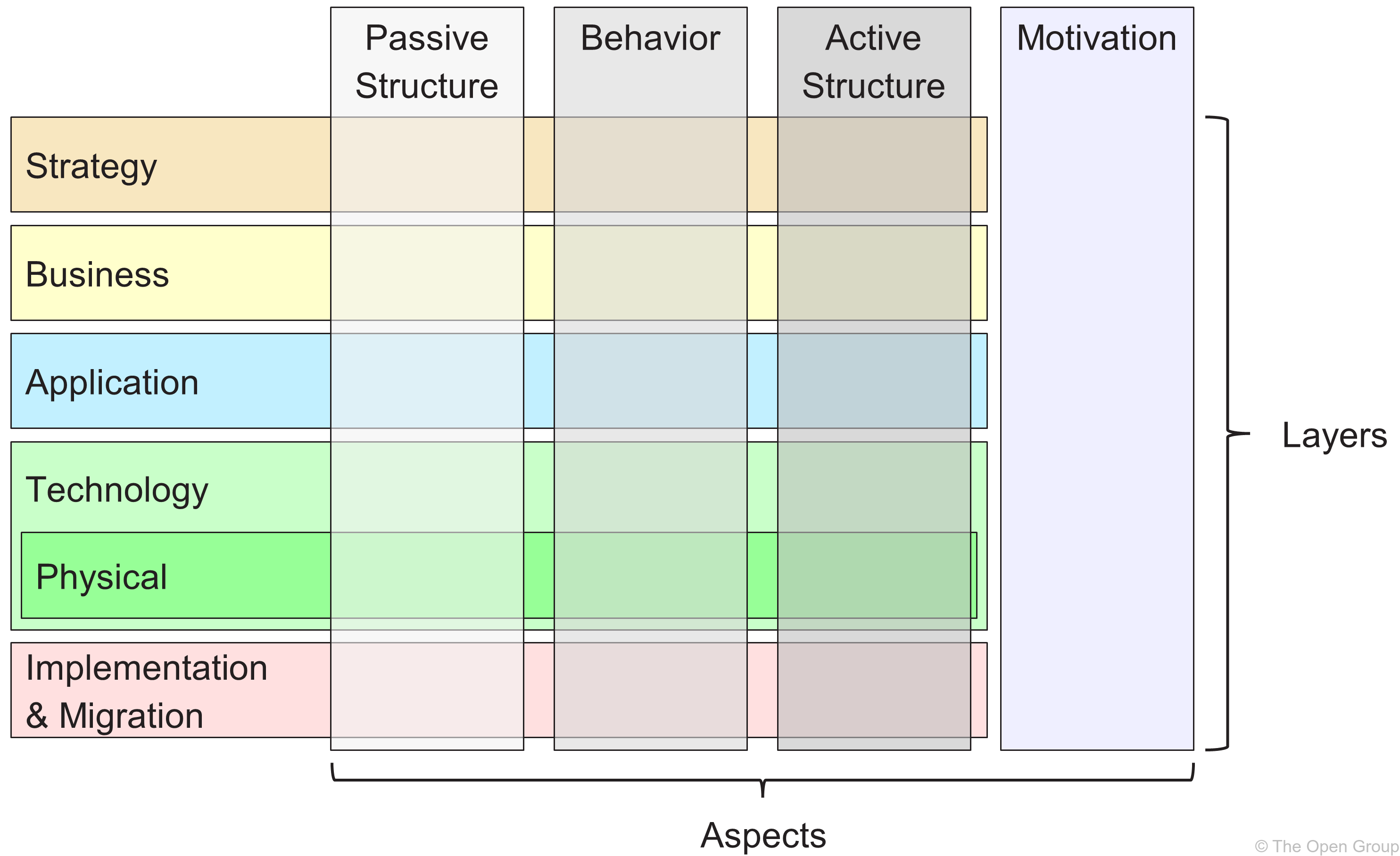1. Introduction
ArchiMate, a widely used enterprise architecture modeling language, provides a structured approach for describing and visualizing different aspects of an organization’s architecture. In this article, we delve into the two key frameworks within ArchiMate—the Core Framework and the Full Framework.
2. ArchiMate Core Framework
The ArchiMate Core Framework serves as the foundation for modeling enterprise architecture. It consists of nine cells organized into three aspects and three layers. These layers—Business, Application, and Technology—allow for a comprehensive representation of an enterprise. The aspects, inspired by natural language structure, include Active Structure, Behavior, and Passive Structure.
2.1 Layers
2.1.1 Business Layer
This layer focuses on business-related elements, such as roles and processes.
2.1.2 Application Layer
Application components, representing software, reside in this layer.
2.1.3 Technology Layer
The Technology Layer involves hardware and infrastructure elements.
2.2 Aspects
2.2.1 Active Structure Aspect
Captures structural elements exhibiting actual behavior, like business actors.
2.2.2 Behavior Aspect
Encompasses processes, functions, events, and services, linking to structural elements.
2.2.3 Passive Structure Aspect
Represents objects on which behavior is performed, often information or data objects.
2.3 Composite Elements
ArchiMate acknowledges composite elements, illustrating that not every element fits neatly into a single aspect or layer.
2.4 Flexibility in Modeling
The language offers flexibility; the modeler is not bound by a specific layout, enhancing adaptability to diverse architectural descriptions.

3. ArchiMate Full Framework
Expanding on the Core Framework, the ArchiMate Full Framework introduces additional layers and an aspect to address more comprehensive enterprise architecture needs.
3.1 New Layers
3.1.1 Physical Layer
Incorporates physical elements for modeling facilities, equipment, and distribution networks.
3.1.2 Strategy Layer
Introduced for modeling strategic direction and choices.
3.2 New Aspect
3.2.1 Motivation Aspect
Explores the generic level of motivation in the architecture, detailed in ArchiMate Manual: Chapter 6.
3.3 Implementation and Migration
Elements related to implementation and migration are introduced in ArchiMate Manual: Chapter 12.
3.4 ArchiMate Full Framework Structure
The resulting ArchiMate Full Framework, depicted in Figure below, showcases the extended layers and aspect.
3.5 Information Modeling
While ArchiMate doesn’t define a specific layer for information, passive structure aspect elements facilitate information entity representation across layers.

4. Conclusion
In conclusion, understanding the ArchiMate Core and Full Frameworks provides architects with a powerful toolkit for expressing the intricacies of enterprise architecture. The Core Framework establishes a solid foundation, while the Full Framework expands the scope, accommodating a broader range of architectural considerations. The flexibility and adaptability inherent in ArchiMate make it a valuable language for effective enterprise architecture modeling.
Unlocking the Potential of Enterprise Architecture with Visual Paradigm
Selecting the right visual modeling tool for Enterprise Architecture (EA) is pivotal to effective communication, collaboration, and decision-making within an organization. Among the plethora of options available, Visual Paradigm emerges as the ultimate choice, offering a comprehensive suite of features tailored for the demands of modern enterprise architecture.
Intuitive Interface and User-Friendly Experience
Visual Paradigm boasts an intuitive and user-friendly interface, making it accessible to both seasoned architects and those new to enterprise modeling. Its drag-and-drop functionality, coupled with a rich library of pre-built elements based on industry standards like ArchiMate, facilitates swift and hassle-free model creation.
ArchiMate Support
As ArchiMate gains prominence as a preferred modeling language for enterprise architecture, Visual Paradigm stands out by providing robust support for ArchiMate notation. The seamless integration of ArchiMate in Visual Paradigm streamlines the modeling process, ensuring that architects can effectively communicate complex architectural concepts.
Comprehensive Feature Set
Visual Paradigm offers a rich set of features tailored for enterprise architects:
Multi-Layered Modeling
Visual Paradigm supports multi-layered modeling, aligning with the depth and complexity inherent in enterprise architecture. Whether you are working on business, application, technology, or strategic layers, Visual Paradigm provides the tools to capture the nuances of each.
Collaboration and Teamwork
Facilitating collaboration is at the core of Visual Paradigm’s design. Its cloud-based solutions enable real-time collaboration, allowing teams distributed across geographies to work seamlessly on the same project. Comments, annotations, and version control enhance teamwork and communication.
Customization and Flexibility
Recognizing the diversity of enterprise architecture needs, Visual Paradigm offers a high degree of customization. Architects can tailor their models to fit specific organizational contexts, ensuring that the tool adapts to the unique requirements of different projects.
Dynamic Reporting and Documentation
Visual Paradigm goes beyond static modeling by providing dynamic reporting and documentation features. This capability ensures that architects can generate comprehensive reports, making it easier to communicate insights and decisions to stakeholders across the organization.
Training and Support
A tool is only as good as the support behind it. Visual Paradigm excels in this regard, offering extensive documentation, tutorials, and a responsive support team. This commitment to user education and support ensures that architects can make the most of the tool’s capabilities.
Visual Paradigm emerges as the ultimate choice for visual modeling in the realm of Enterprise Architecture. Its intuitive interface, ArchiMate support, comprehensive feature set, collaboration capabilities, and robust support make it an indispensable tool for architects navigating the complexities of modern enterprise environments. By choosing Visual Paradigm, organizations can unlock the full potential of their enterprise architecture initiatives.
Resources
- What is ArchiMate?
- Archimate Core Framework: A Brief Explanation
- Understanding ArchiMate Key Concepts: A Comprehensive Guide
- ArchiMate – The Core Framework | ArchiMate Quick Guide
- Understanding the Purpose of ArchiMate: A Guide for Enterprise Architects
- ArchiMate Core Framework | Enterprise Architect User Guide
- ArchiMate 3 core framework (adapted from [59]) | Download Scientific Diagram
- ArchiMate Core Framework Example · ArchiMate Concepts & FAQ
- ArchiMate Core Framework Example
- An Overview of ArchiMate – the Enterprise Architecture Modeling Language
- ArchiMate Diagram Tutorial
- TOGAF® Tool for Enterprise Architecture
- ArchiMate 101: A Practical Introduction
- Comprehensive Tutorial on ArchiMate
- ArchiMate – Wikipedia 79.
- Understanding ArchiMate Key Concepts: A Comprehensive Guide 81.
- Visual-paradigm 82.
- Introduction: ArchiMate® 3.2 Specification 83.